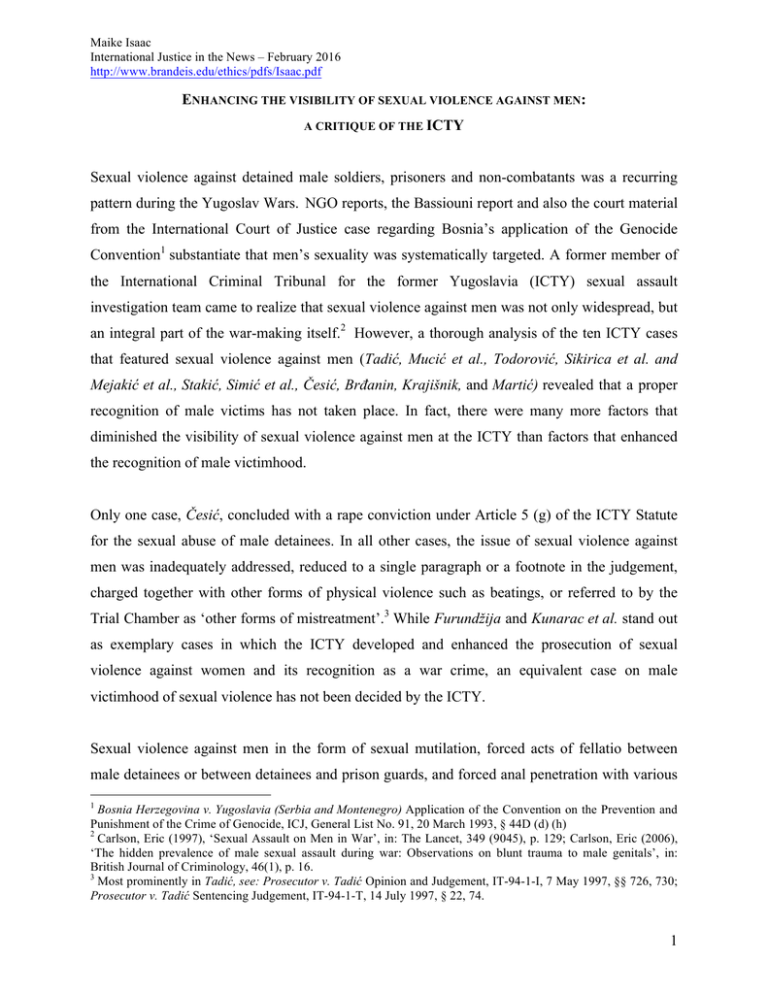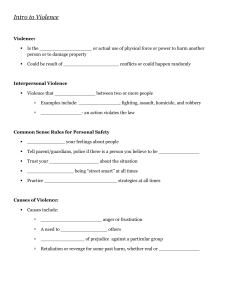
Maike Isaac
International Justice in the News – February 2016
http://www.brandeis.edu/ethics/pdfs/Isaac.pdf
ENHANCING THE VISIBILITY OF SEXUAL VIOLENCE AGAINST MEN:
A CRITIQUE OF THE ICTY
Sexual violence against detained male soldiers, prisoners and non-combatants was a recurring
pattern during the Yugoslav Wars. NGO reports, the Bassiouni report and also the court material
from the International Court of Justice case regarding Bosnia’s application of the Genocide
Convention1 substantiate that men’s sexuality was systematically targeted. A former member of
the International Criminal Tribunal for the former Yugoslavia (ICTY) sexual assault
investigation team came to realize that sexual violence against men was not only widespread, but
an integral part of the war-making itself.2 However, a thorough analysis of the ten ICTY cases
that featured sexual violence against men (Tadić, Mucić et al., Todorović, Sikirica et al. and
Mejakić et al., Stakić, Simić et al., Česić, Brđanin, Krajišnik, and Martić) revealed that a proper
recognition of male victims has not taken place. In fact, there were many more factors that
diminished the visibility of sexual violence against men at the ICTY than factors that enhanced
the recognition of male victimhood.
Only one case, Česić, concluded with a rape conviction under Article 5 (g) of the ICTY Statute
for the sexual abuse of male detainees. In all other cases, the issue of sexual violence against
men was inadequately addressed, reduced to a single paragraph or a footnote in the judgement,
charged together with other forms of physical violence such as beatings, or referred to by the
Trial Chamber as ‘other forms of mistreatment’.3 While Furundžija and Kunarac et al. stand out
as exemplary cases in which the ICTY developed and enhanced the prosecution of sexual
violence against women and its recognition as a war crime, an equivalent case on male
victimhood of sexual violence has not been decided by the ICTY.
Sexual violence against men in the form of sexual mutilation, forced acts of fellatio between
male detainees or between detainees and prison guards, and forced anal penetration with various
1
Bosnia Herzegovina v. Yugoslavia (Serbia and Montenegro) Application of the Convention on the Prevention and
Punishment of the Crime of Genocide, ICJ, General List No. 91, 20 March 1993, § 44D (d) (h)
2
Carlson, Eric (1997), ‘Sexual Assault on Men in War’, in: The Lancet, 349 (9045), p. 129; Carlson, Eric (2006),
‘The hidden prevalence of male sexual assault during war: Observations on blunt trauma to male genitals’, in:
British Journal of Criminology, 46(1), p. 16.
3
Most prominently in Tadić, see: Prosecutor v. Tadić Opinion and Judgement, IT-94-1-I, 7 May 1997, §§ 726, 730;
Prosecutor v. Tadić Sentencing Judgement, IT-94-1-T, 14 July 1997, § 22, 74.
1
Maike Isaac
International Justice in the News – February 2016
http://www.brandeis.edu/ethics/pdfs/Isaac.pdf
objects has been prosecuted at the ICTY alongside or as other forms of physical mistreatment
under a charge of torture, cruel or inhuman treatment, or the wilful causing of great suffering or
serious injury. This is a problem in that it hinders men from being recognized as a targeted group
for sexual violence in armed conflict.
The ICTY established in Mucić et al. that rape is a form of torture. Undoubtedly, including rape
under the umbrella of the prohibition of torture has advanced its recognition as a tool of warfare.
Particularly in the context of the ICTY Statute, where rape is only explicitly listed as an offence
under crimes against humanity, the understanding of rape as torture has been an advantage for
the Prosecution. It allows rape to be prosecuted as a grave breach of the Geneva Conventions or
a violation of the laws and customs of war when the chapeau requirements for crimes against
humanity are not fulfilled. However, rape and torture are distinct offences in terms of intent of
the perpetrator and effects on the victim. Therefore, sexual violence should be charged and
prosecuted as both rape and torture when the circumstances of the case allow.
Like sexual violence against women, sexual violence against men changes a man’s position in
society. Depending on the societal and cultural context, the male victim is often perceived as no
longer being a real man, because he was not able to protect himself and was put into the
stereotypically submissive role of a woman (‘feminization’). In the context of male-to-male
sexual violence (i.e. forced acts of fellatio or anal penetration between two men who are both
victims of the offence), the victim is, as Sandesh Sivakumaran puts it, ‘tainted’ with
homosexuality through which societal attitudes towards him are changed, often leading to
societal isolation. All of the above are part of the plan of the perpetrator when sexually abusing a
man. The perpetrator purposely targets societal expectations in regards to both femininity and
masculinity in order to shatter societal structures and to break the victim through an extreme
form of degradation. Thus, especially when the offence is committed in such a systematic
manner as in the Yugoslav Wars, the purpose of the sexual assault goes beyond the scope of the
prohibition of torture, which has been defined by the ICTY as an intentional act or omission that
causes severe pain or suffering for the purpose of obtaining information or a confession,
punishment, intimidation or discrimination. Even when discrimination, intimidation or
2
Maike Isaac
International Justice in the News – February 2016
http://www.brandeis.edu/ethics/pdfs/Isaac.pdf
punishment is intended on part of the perpetrator, a charge on torture does not adequately address
the societal long-term consequences for the male victim.
The prohibition of rape, as it was defined in Furundžija, does not explicitly refer to the emotions
of the victim or the motive of the perpetrator. Yet, a charge of rape under Article 5 (g) of the
ICTY Statute has the advantage of unequivocally stating that the offence was sexual in nature
and that the sexuality of the victim was targeted without his consent. This enhances the visibility
and recognition of male victimhood through sexual violence. An accurate categorization of
sexual abuse would help to combat stereotypes about masculinity that make male rape such a
powerful means of warfare in the first place.
Under the ICTY Statute, the Prosecution had no alternative but to charge cases of sexual
mutilation or other forms of sexual violence short of sexual penetration as torture or as less
severe forms of physical and psychological mistreatment. To critique the Statute of the ICTY, it
is problematic that the only separate crime of a sexual nature is rape and that rape is listed only
as a crime against humanity in Article 5. And yet, although the ICTY Statute clearly limits the
options of recognizing male victimhood through sexual violence, the respective Trial Chambers
carry a degree of responsibility for this minimal recognition. Instead of circumventing the limits
of the Statute by emphasizing the sexual nature of specific acts committed against men under a
charge of torture, inhumane or cruel treatment, the judicial authorities at the ICTY frequently
opted to refer to those acts as other forms of violence or mistreatment. In this way, the sexual
nature of many offences committed against men during the Yugoslav Wars was swept under the
carpet.
In summary, while the recognition of sexual violence against women, despite the constraints of
the Statute, is one of the major achievements of the Ad Hoc Tribunal, sexual violence against
men was largely understated. To this extent, the Tribunal has not fully utilized its power to
advance the understanding of gender-based violence during armed conflict.
3




